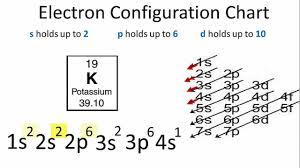Question
Question: The electron configuration for Potassium in the ground state: (A)- \(1{{s}^{2}}2{{s}^{2}}2{{p}^{6}...
The electron configuration for Potassium in the ground state:
(A)- 1s22s22p63s23p6
(B)- 1s22s22p63s23p64s2
(C)- 1s22s22p63s23p64s1
(D)- 1s2
(E)- 1s22s22p63p1
Solution
Hint: Potassium in the ground state has 19 electrons and the shell structure is 2,8,8,1. To fill electrons in the orbitals there are some rules we must keep in mind namely Hund’s rule and Aufbau principle.
Complete step by step solution:
In order to write the Potassium electron configuration we first need to know the number of electrons for the K atom. When we write the configuration we'll put all 19 electrons in orbitals around the nucleus of the Potassium atom.
We need to distribute 19 electrons, knowing that there can be
- 2 in an s-orbital
- 6 in a p-orbital (2 in px, 2 in py and 2 in pz)
- 10 in a d-orbital
We won’t need f-orbitals before atomic number 58.
The energy of an electron in a single electron atom can be determined by the principal quantum number. Thus, the order of increase in energy of various orbitals is given as, 1s < 2s = 2p < 3s = 3p = 3d <4s = 4p = 4d= 4f. But a multiple electron system (n+l) rule involving principal and azimuthal quantum numbers is followed although we do not need to apply it here.
In writing the electron configuration for Potassium the first two electrons will go in the 1s orbital. Since 1s can only hold two electrons the next 2 electrons for Potassium go in the 2s orbital.
The next six electrons will go in the 2p orbital. The p orbital can hold up to six electrons. We'll put six in the 2p orbital and then put the next two electrons in the 3s.
Since the 3s are now full we'll move to the 3p where we'll place the next six electrons.
We now shift to the 4s orbital where we place the remaining electron.

Therefore the Potassium electron configuration will be 1s22s22p63s23p64s1.
Hence, Option C is the correct answer.
Note: The electronic configuration provides an easy way for scientists to understand how electrons are arranged around the nucleus of an atom. This makes it easier to predict how atoms will interact to form chemical bonds.
